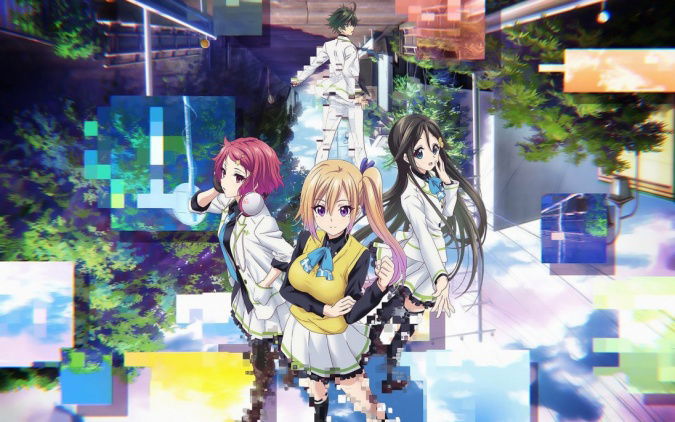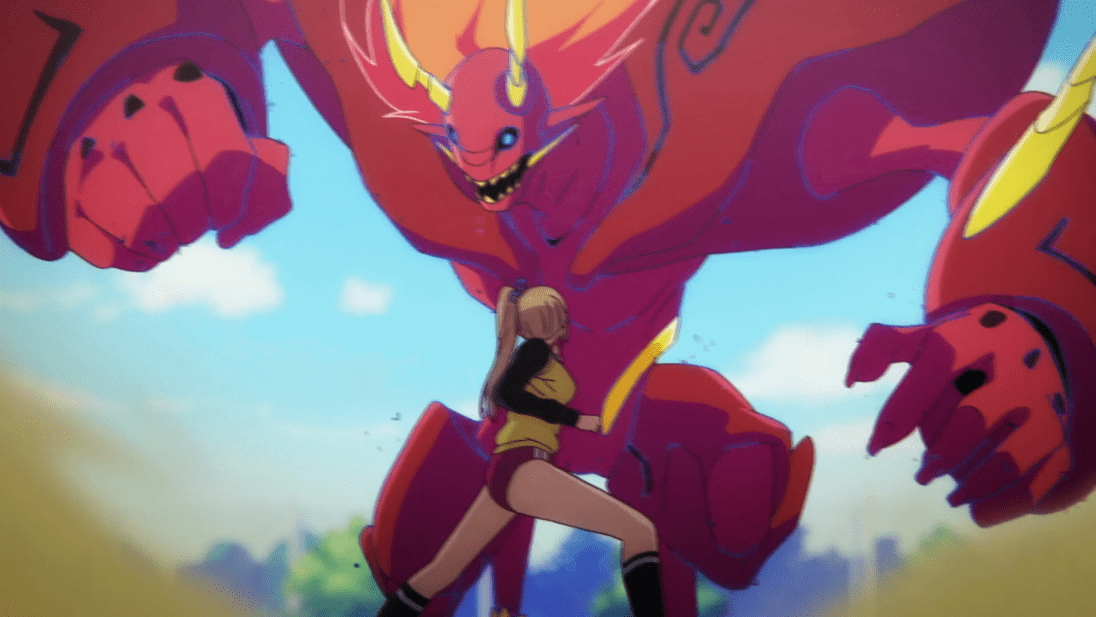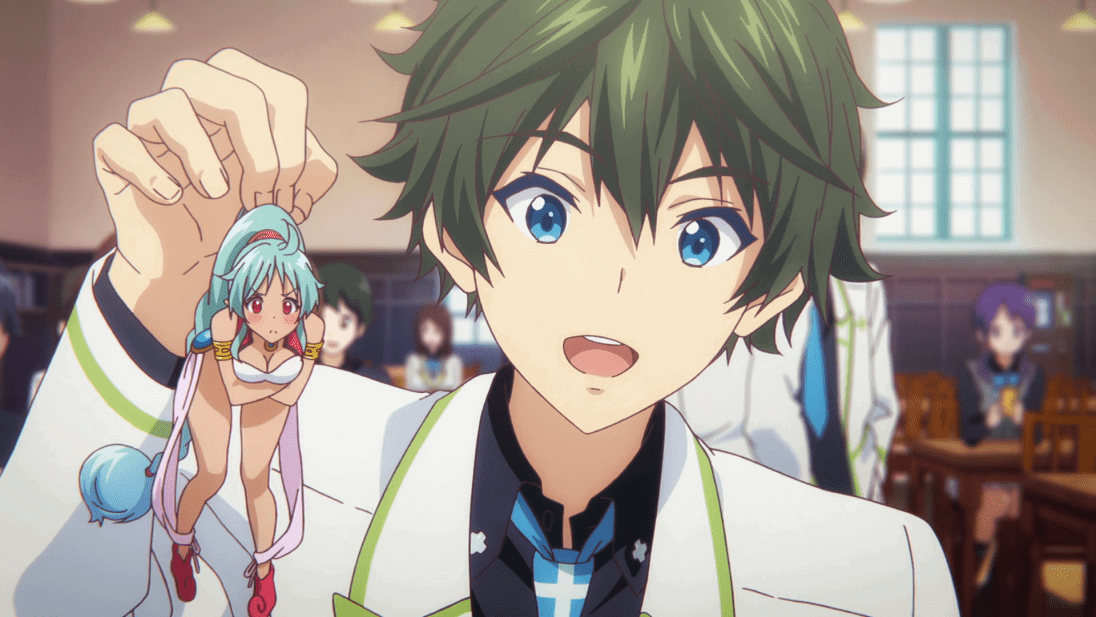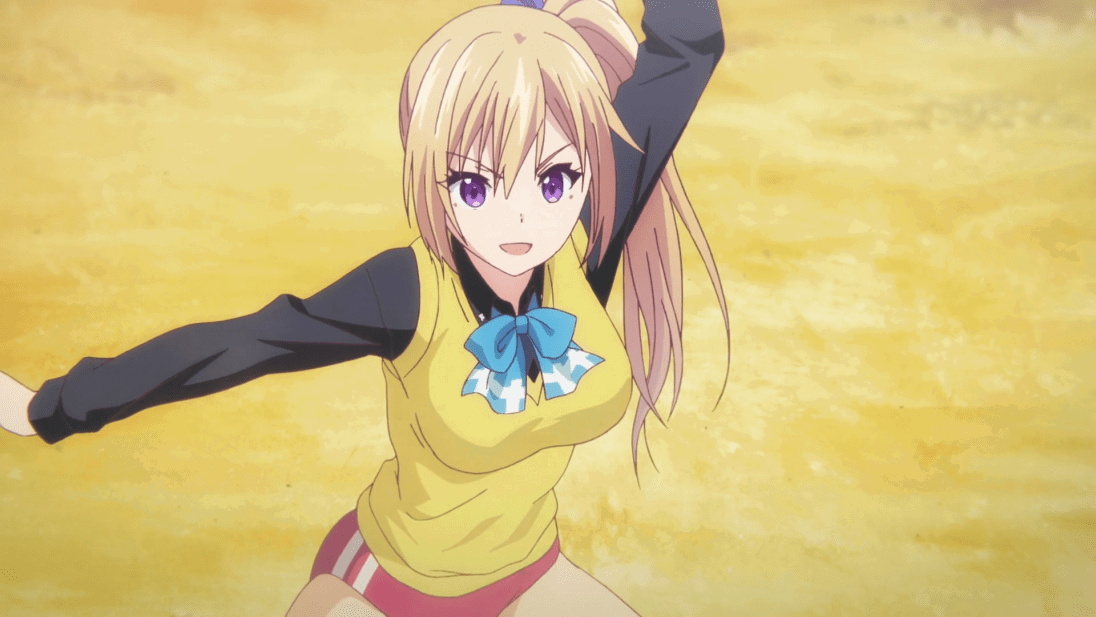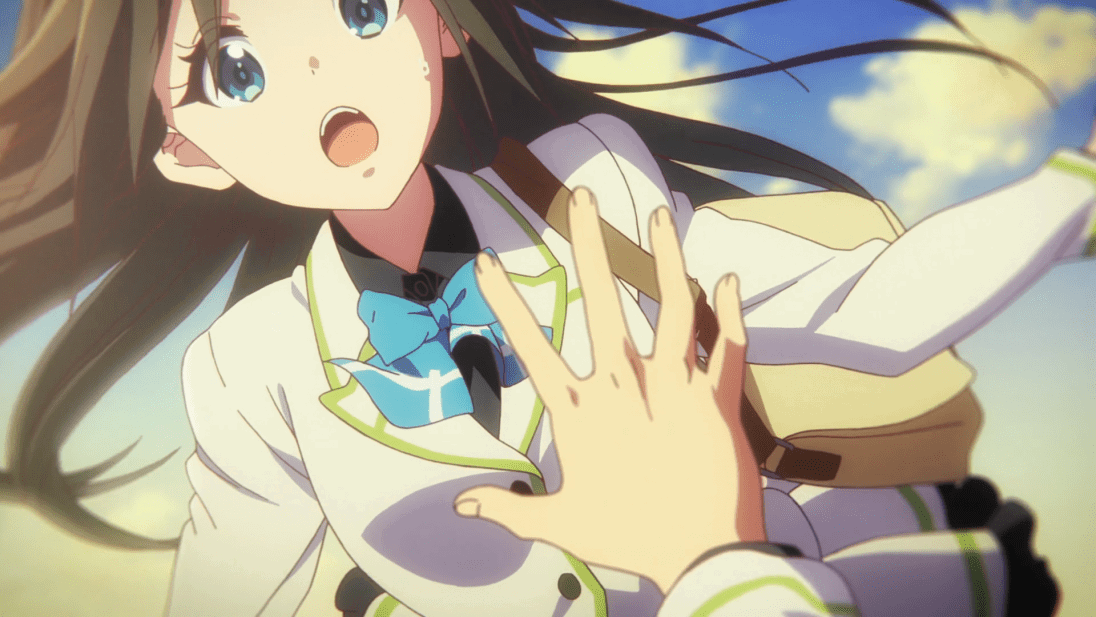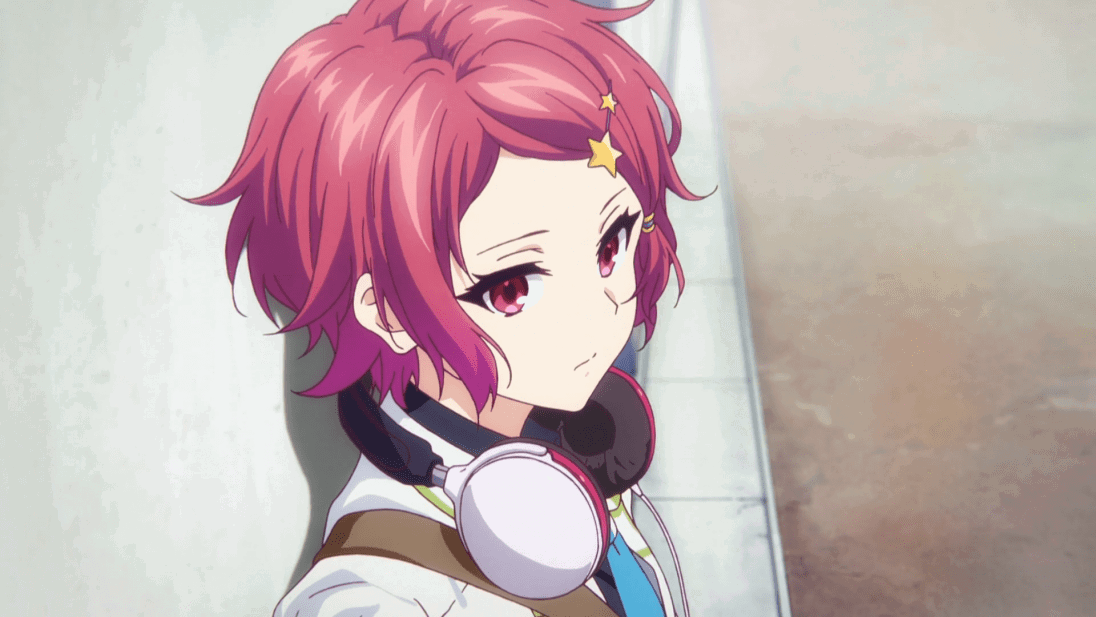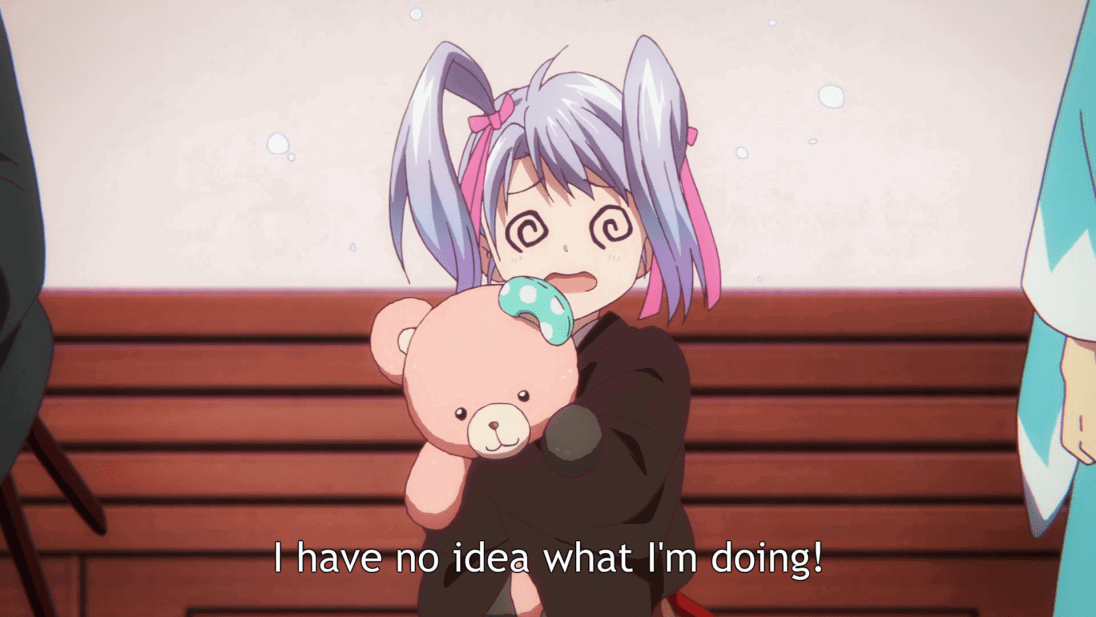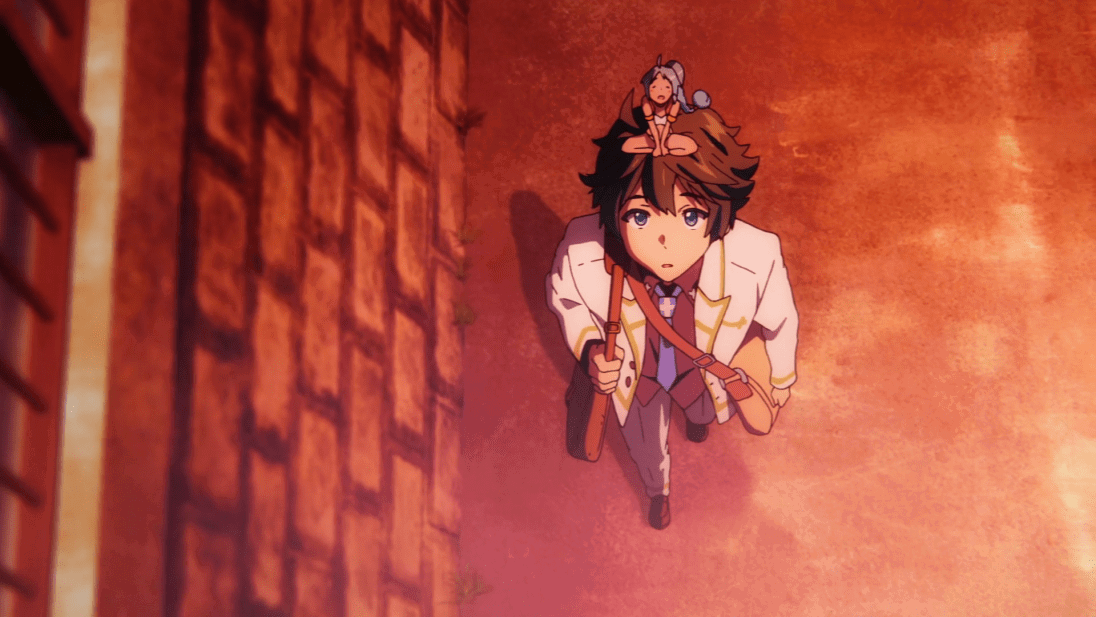It is no secret that I am a fan of the harem genre of anime in all forms; on one end there are more shameless and lewd harems such as To Love Ru and Monster Musume. On the other, there are also “soft harems” such as Food Wars which have their share of raunchy jokes, but eschew focus on romance and self-insert protagonists in favor of its own high concept. In Myriad Colors Phantom World, this premise is demon hunting. Seems simple enough, so let’s dive in!
Story
A bit over a decade ago, a terrorist bombing caused an experimental virus to leak from an affected facility and infect the local populous. Though not fatal, this virus changed the fundamental way that the human brain functioned in those affected; as a result, people could now see and interact with phantoms: creatures from myths and legends once thought imaginary or only visible to a select few. On top of this, children born around or after the event experienced a change in themselves; many gained special abilities which could be used to combat and/or seal away the newly tangible phantoms.
Though initially dealing with phantoms seemed it would be an issue, phantom hunting became a fairly prolific activity. Even in schools like Hosea Academy, phantom hunting is offered as an extra-curricular activity which even compensates its participants upon task completion (albeit in goods as opposed to currency). Haruhiko Ichijou and his not-so-incidentally all-female team is one such group of hunters.
Myriad Colors is a strange fusion of slice of life and shounen styles, and that works to its advantage. Each episode, the main cast is confronted by some sort of phantom and must defeat it through either some sort of group effort or diplomacy. The premise is somewhat pedestrian, but it’s what the series does with the formula that matters most. Specifically speaking, in many shounen anime the protagonist(s) will typically rely most on their trusted/developmental techniques to defeat their enemy and character development (if any) will come through how that particular enemy made them approach the situation. Here, character development comes first and the enemy is almost incidental. This allows the ties that bind the main cast to grow stronger as they go along, going so far as to justify the girls’ feelings towards the protagonist.
Characters
Haruhiko Ichijou (and Ruru)
Our main protagonist and Hosea Academy first year, Haruhiko is a well-read and somewhat serious young man. Though he is full of useless knowledge, he is quick to help a friend in need and loyal to his phantom hunting group. As a hunter, Haruhiko is able to seal phantoms by drawing them in his sketchbook; in addition, he can also use his sketchbook to summon phantoms at the cost of a blood sacrifice.
So close is she to Haruhiko, it would be more prudent to introduce Ruru here than in her own entry.
Ruru is a small, genie-like phantom with an extremely loud personality. Lacking in any significant powers, Ruru mostly just follows Haruhiko wherever he goes as she has done since he was in middle school. By the strictest possible definition, she is a member of the harem, and in such shows a level of romantic interest in Haruhiko (granted, her loud and playful nature may imply level of teasing) despite the mind-boggling question as to how that would even work.
As the absolute core of the series, this pair holds their own quite well. Thanks to the soft herem genre’s freedoms, Haruhiko is a well-developed character with tangible personality and emotion. His father is always away on business and his mother left when he was young, and despite his overall cheery nature, that feeling of loneliness is felt through his exchanges with others and in times when he finds himself alone. As such, Ruru becomes a stronger character as well, always being there to annoy and interact with Haruhiko to keep him from feeling truly alone despite living in a large house all on his own.
Mai Kawakami
A hot-headed martial artist and Hosea Academy second year, Mai uses both her combat training and her ability to access the five core elements to weaken phantoms for capture. The running gag is that every phantom is connected to an element and Mai must use the element that beats it, in order to do this, she must stimulate the organ(s) corresponding to the chosen element (heart for fire, kidneys for water, Etc) and in the process ends up fondling herself or drawing attention to her sizable assets.
As a character, Mai plays the Onee-chan role, but a bit differently than in most harems. Often times when you see a character in a harem described as the “Onee-chan,” a teasing seductress comes to mind. In Myriad Colors however, this role is cast like a realistically loving older sister to Haruhiko: she picks on him, scolds him, and generally tries to act superior to him. Of course, like any older sister, she does care about our hero more than she might let on.
Reina Izumi
Another first year at Hosea, Reina was born with the rare powers of a phantom eater. This gives her the ability to seal phantoms by opening her mouth impossibly wide and sucking them in; a process that is much faster and more efficient than drawing.
As far as personality goes, Reina is mild-mannered and shy due to having come from a strict household. In addition, she fills the hungry character trope due to her power, which nobody truly understands the specifics of.
Typically, her role is to seal phantoms and react violently when Haruhiko comes in accidental contact with her despite being palpably interested in him.
Koito Minase
The distant, emotionless transfer student; Koito can use her voice to create powerful shockwaves that can stun, damage, or even seal phantoms.
Among the girls, Koito is the most loyal to the harem formula: she is generally lonely and unfeeling but warms up to the protagonist through his repeated kindness towards her. Nothing ground-breaking, but the character is given good enough motivation and story throughout the series to feel genuine.
Kurumi Kumamakura
(minor plot spoilers)
A plucky fourth-grader at Hosea’s grade school, Kurumi initially follows Haruhiko and Mai around in awe of their strength and teamwork. Eventually though, she is called to action by strenuous circumstances. What could such a tiny little girl who goes nowhere without her teddy bear do to help? Well obviously she sends in the bear to fight for her. That’s right, thanks to her special ability, Kurumi can make her teddy bear, Albrecht, grow many times his own size and gain sentience to fight for his owner and best friend. That’s actually pretty rad.
Now, as difficult as this is to say, she is indeed part of the harem in a sense. However, thanks to the style of harem, nothing particularly haram goes down. To be specific, in one episode, Haruhiko is turned into a child and the first person he runs into is Kurumi; he doesn’t recognize her as his memories are reset to his current age, and she is unaware that he was transformed. Kurumi is very kind to him and does everything she can to help him, complete with cheesy scene alone on the school steps where she assures him everything will be okay. Normally something like this would be questionable as a reason to induct her into the harem, but it’s the kind of situation that sets up the “childhood friend” trope, so I’m counting it.
Production Value
Simply put, Myriad Colors is beautiful in its execution; the characters are well-designed and fitting of their personalities, the environments are lush and colorful, and the pixel/digitized effect on the phantoms is executed fantastically. The series will most take place around the Hosea Academy or in the city around it, but thanks to the psychological nature of phantoms, any environment is possible. Through this principal, the settings all throughout are reasonably varied.
It isn’t only variety though, every location throughout the series is given a strong atmosphere in which their essence truly shines. Abandoned factories look dusty and decrepit, wooded areas feel lush and green, and the city feels full and lively. It’s a certain je ne sais quoi that says “yes, this is what it’s supposed to be, but a tiny bit moreso.”
Sound design overall is strong, but par for the course. Generally speaking, it fits into the “everything works, but nothing outside of the OP is more than you’d expect” genre. With that said, the electronica OP to this one is pretty catchy, and definitely made it on my list of OPs I never skip. Otherwise not much is to be said about the sound design: sound effects are on point, music fits its purpose, and characters are well-voiced.
Overall Thoughts
Myriad Colors Phantom World catches more flak than I feel it deserves. Yes, perhaps the overarching premise is a tad generic and the characters are a bit married to tropes, but the development between all of these elements is still strong. It’s not anything ground-breaking, but it really doesn’t need to be; you don’t have to re-invent the wheel to make an enjoyable cast of characters experience heartfelt moments and tense situations, and that’s exactly what Myriad Colors has done.
If you’re aching for innovation, you won’t necessarily find it here, but if you value strong character interaction with amusing comedic relief and the occasional dip into typical harem humor, you’ll have a good time.
Myriad Colors Phantom World
Final Word
I’ve said it once, I’ll say it again: Myriad Colors Phantom World does not reinvent the wheel. However, what it lacks in inherent innovation it makes up with quality characters and equally strong interaction between them; this is especially true for the “untouchable” characters (Ruru and Kurumi), who are given functional excuses for at least mildly romantic interaction with Haruhiko.
If you’re here for a crazy combat anime, you might be slightly disappointed. However, if what I’ve described sounds good to you, Myriad Colors is definitely worth the time of day.
-
Top-notch limbo tech


